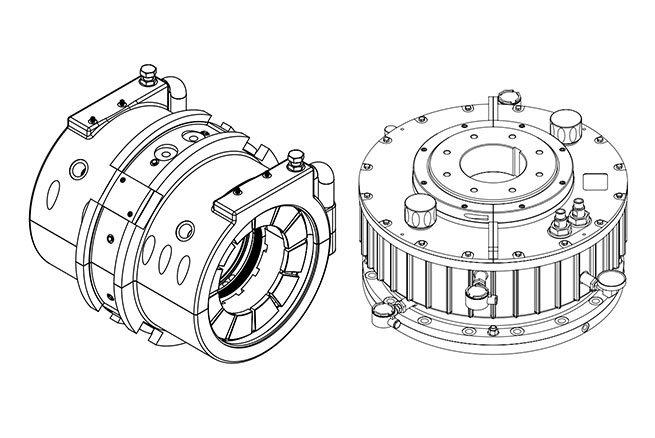Should the clearance of motor bearings be reasonably set according to different types of motors and working requirements?
Motors are one of the indispensable key components in modern industry and are widely used in various fields, including industrial production, agriculture, transportation, home appliances, etc. During the operation of the motor, bearings play a vital role. They support and limit the movement of the motor rotor, bear axial and radial forces during the operation of the motor, and play the functions of reducing friction, shock absorption, positioning, etc. .
In the motor manufacturing process, there are different requirements for axial and radial clearances for different types of motors. Axial clearance refers to the gap between the motor shaft and the end face of the bearing cavity. It plays an important role in the positioning of the motor rotor and the axial stability of the rotation. Therefore, the axial clearance should be set correctly according to the importance of motor rotation. Generally speaking, high-precision, high-speed motors require smaller axial clearances to ensure accurate positioning of the rotor and balanced rotation. For some low-speed motors or motors with low working requirements, the axial clearance can be appropriately increased to reduce manufacturing costs and simplify the assembly process.
Radial clearance refers to the gap between the motor shaft and the bearing bore. It also has an important impact on the performance of the motor such as rotational friction, noise and vibration. For some motors that require high precision, such as precision machine tool motors, high-speed motors, etc., the radial clearance should be minimized. Because a smaller radial gap can improve the rotor positioning accuracy and vibration resistance of the motor, and reduce the radial deviation and vibration of the rotor. For some motors with low precision requirements, the radial clearance can be appropriately increased to reduce manufacturing costs and simplify the assembly process.
In actual production, the clearance of
motor bearings is achieved through precise processing and assembly. First of all, the machining accuracy of the bearing must meet the design requirements, ensure the dimensional accuracy of the inner and outer diameters, and control the roundness and parallelism. Secondly, during the motor assembly process, attention should be paid to controlling the assembly pressure and temperature of the bearings to avoid unnecessary deformation and clearance deviations. At the same time, during the assembly process, the clearance of the motor bearings can be controlled by adjusting the assembly accuracy or using gaskets, aligning sleeves, etc. according to the actual situation.
The clearance of the motor bearings should be reasonably set according to the different types of motors and working requirements. Appropriate axial and radial clearance can ensure the normal operation and stability of the motor, and improve the life and operating efficiency of the motor. During the motor manufacturing and assembly process, the processing and assembly accuracy should be strictly controlled to ensure the accuracy and reliability of the bearing clearance. Only in this way can we produce motor products with excellent performance and meet the needs of various industries for machines.
Is it important to ensure the dynamic balance of motor bearings in a high-speed environment?
In high-speed environments, the dynamic balance of
motor bearings is very important. Dynamic balance means that during the high-speed rotation of the motor rotor, the mass is evenly distributed and the bearing force is balanced to avoid vibration and force caused by poor dynamic balance. If the motor bearings have poor dynamic balance problems, it will have a negative impact on the working efficiency and service life of the motor.
Poor dynamic balancing can cause bearings to be subjected to additional vibrations and forces. During the high-speed rotation process, the motor rotor has certain mass unevenness. If it is not accurately dynamically balanced, the motor rotor will produce uneven centrifugal force. These uneven centrifugal forces will cause the bearing to be subject to additional vibration and force during rotation, increasing the load on the bearing. If the load exceeds the bearing capacity, the bearing is likely to be damaged or even fail prematurely.
Poor dynamic balance will reduce the working efficiency of the motor. Due to the uneven distribution of mass, the motor rotor will produce irregular vibrations during high-speed rotation. These vibrations will make the operation of the motor unstable, increase friction and energy loss, and further reduce the efficiency of the motor. In addition, unstable operating conditions can also cause noise and vibration problems, interfering with the normal operation of the motor and the use environment.
Poor dynamic balance will also shorten the service life of the motor. Uneven centrifugal force and vibration will cause additional load and wear on the bearings, accelerating the wear and aging process of the bearings. Over time, these problems will accumulate, eventually leading to bearing damage and failure. Once the bearing fails, the operation of the entire motor will be interrupted and the bearing needs to be replaced, increasing the cost of repair and replacement.
In a high-speed environment, it is very important to ensure the dynamic balance of motor bearings. Dynamic balancing processing can be achieved through a variety of methods, such as using a professional dynamic balancing machine for precise dynamic balancing correction, or using a device with uniform mass distribution such as a balancing iron or a balancing disc for compensation. By ensuring the dynamic balance of the bearings, additional vibration and force can be effectively avoided, and the working efficiency and service life of the motor can be improved.
